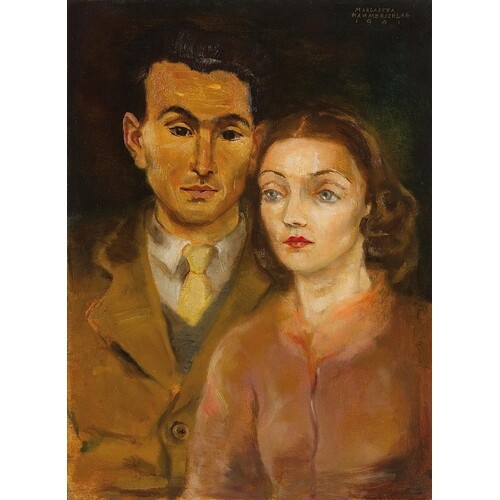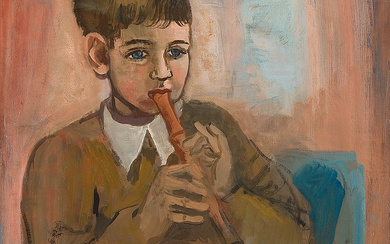MARGARETE BERGER-HAMERSCHLAG* (Vienna 1902 - 1958 London) ...
MARGARETE BERGER-HAMERSCHLAG*
(Vienna 1902 - 1958 London)
Joan Gili i Serra with wife
oil/canvas, 66 x 48 cm
signed Margarete Hamerschlag, dated 1941
Austrian painter, author and illustrator of the 20th century. Came from a Jewish family. Attended the youth art class with Franz Cizek from 1910. From 1917 studied at the Kunstgewerbeschule under Bertold Löffler, Oskar Strnad and Eduard Wimmer-Wisgrill. From 1920 illustrations for books of the Wiener Werkstätte, designs for costumes and editorial member of the magazine Wiener Mode. 1922 marriage to the architect and student of Adolfs Loos, Joseph Berger. Lived in the artists' colony on Rosenhügel from 1924 to 1934. Extraordinary member of the Hagenbund. 1927 Participated in the first Viennese women's art exhibition. 1936 Emigration to England. Lived in London as a portraitist, book illustrator and art educator. Created landscapes, still lifes and portraits and, among others, a series of paintings from the Youth Club, where she worked in London.
On the recommendation of Koloman Moser, Margarete Hamerschlag, who came from a middle-class Jewish family, attended art classes with Franz ?ižek at the age of nine. From 1917 to 1922 she studied at the Vienna School of Applied Arts with Oskar Strnad, Eduard Wimmer-Wisgrill and Bertold Löffler. In 1922 she married Josef Berger, architect and student of Adolf Loos. Afterwards she was successful as a book illustrator, painter, watercolorist and woodcut artist as well as a costume designer. The decorative style of the Wiener Werkstätte was soon mixed with grimaces, demons, and figures marked by greed and fear. In 1927 she took part in the first exhibition of women's art in Vienna. Frustrated by the lack of artistic development opportunities and bitterness about the establishment of the Austro-Fascist regime, the couple moved to the British Mandate of Palestine in 1934 because Berger had received a contract to build a hotel in Haifa. For about a year, Berger worked on the hotel plans on the one hand and on the other hand was looking for follow-up orders. Meanwhile, Hamerschlag traveled to Palestine, Syria and Lebanon on his own and recorded his experiences in numerous sketches, paintings and written records. In Haifa, she designed costumes for Yardena Cohen, who would later be considered one of the founders of modern dance in the founding days of Israel. Her work was shown in a gallery in Jerusalem at the time, as well as part of an exhibition of contemporary Austrian art in Košice, Czechoslovakia. In Haifa, the couple, who were Jewish by origin but distanced themselves from religious Judaism, maintained lively contacts with German-speaking immigrants who saw themselves less as Zionist pioneers than as temporary refugees. When tensions between Jews and Arabs in Palestine increased, the Berger-Hamerschlag couple decided to leave the Mandate for England. In December 1935, Hamerschlag traveled by ship from Haifa to London. Berger followed in the following year. After surviving internment in 1940, Berger found a job at the London County Council. Hamerschlag kept in touch with Georg Ehrlich and other emigrants, but also quickly made contact with the English art scene and soon took part in group exhibitions. After the end of the war it called itself Berger-Hamerschlag. She was able to build on her earlier artistic successes and undertook artistically productive journeys, particularly through southern Europe. In addition, she made a name for herself teaching in various London youth clubs.
PORTRAIT JOAN GILI I SERRA
The portraits of the artist Berger-Hamerschlag, in which she continued her personal, lyrical style of the pre-war period, show the portrayed thoughtfully and pensively. The artist approaches them with love and keen interest, but respectfully maintains a distance. What is really going on in them remains ultimately unfathomable. Dressed in light shades of brown as if for a cool autumn day, the couple portrays the Catalan bookseller, publisher and translator Joan Gili i Serra, who moved to London in 1934 and came not as a political refugee but out of intellectual interest, and his wife Elizabeth McPherson. In interviews Older Englishmen regularly say that they remember brown as the dominant colour in England in the 1940s, and emphasize that this is not only due to the sepia brown photos of that time. Clothes, furniture, wallpaper, houses, everything was brown. This double portrait could serve as evidence for this. Hamerschlag seems to have been particularly interested in the almost stereotypical contrast that results from the close juxtaposition of the Mediterranean-dark-haired Joan Gili and his strawberry-blonde, British wife with the almost transparent-white complexion.
SCHÄTZPREIS/ESTIMATE °€ 1.000 - 3.000
Sale price
Estimate
Time, Location
Auction House
MARGARETE BERGER-HAMERSCHLAG*
(Vienna 1902 - 1958 London)
Joan Gili i Serra with wife
oil/canvas, 66 x 48 cm
signed Margarete Hamerschlag, dated 1941
Austrian painter, author and illustrator of the 20th century. Came from a Jewish family. Attended the youth art class with Franz Cizek from 1910. From 1917 studied at the Kunstgewerbeschule under Bertold Löffler, Oskar Strnad and Eduard Wimmer-Wisgrill. From 1920 illustrations for books of the Wiener Werkstätte, designs for costumes and editorial member of the magazine Wiener Mode. 1922 marriage to the architect and student of Adolfs Loos, Joseph Berger. Lived in the artists' colony on Rosenhügel from 1924 to 1934. Extraordinary member of the Hagenbund. 1927 Participated in the first Viennese women's art exhibition. 1936 Emigration to England. Lived in London as a portraitist, book illustrator and art educator. Created landscapes, still lifes and portraits and, among others, a series of paintings from the Youth Club, where she worked in London.
On the recommendation of Koloman Moser, Margarete Hamerschlag, who came from a middle-class Jewish family, attended art classes with Franz ?ižek at the age of nine. From 1917 to 1922 she studied at the Vienna School of Applied Arts with Oskar Strnad, Eduard Wimmer-Wisgrill and Bertold Löffler. In 1922 she married Josef Berger, architect and student of Adolf Loos. Afterwards she was successful as a book illustrator, painter, watercolorist and woodcut artist as well as a costume designer. The decorative style of the Wiener Werkstätte was soon mixed with grimaces, demons, and figures marked by greed and fear. In 1927 she took part in the first exhibition of women's art in Vienna. Frustrated by the lack of artistic development opportunities and bitterness about the establishment of the Austro-Fascist regime, the couple moved to the British Mandate of Palestine in 1934 because Berger had received a contract to build a hotel in Haifa. For about a year, Berger worked on the hotel plans on the one hand and on the other hand was looking for follow-up orders. Meanwhile, Hamerschlag traveled to Palestine, Syria and Lebanon on his own and recorded his experiences in numerous sketches, paintings and written records. In Haifa, she designed costumes for Yardena Cohen, who would later be considered one of the founders of modern dance in the founding days of Israel. Her work was shown in a gallery in Jerusalem at the time, as well as part of an exhibition of contemporary Austrian art in Košice, Czechoslovakia. In Haifa, the couple, who were Jewish by origin but distanced themselves from religious Judaism, maintained lively contacts with German-speaking immigrants who saw themselves less as Zionist pioneers than as temporary refugees. When tensions between Jews and Arabs in Palestine increased, the Berger-Hamerschlag couple decided to leave the Mandate for England. In December 1935, Hamerschlag traveled by ship from Haifa to London. Berger followed in the following year. After surviving internment in 1940, Berger found a job at the London County Council. Hamerschlag kept in touch with Georg Ehrlich and other emigrants, but also quickly made contact with the English art scene and soon took part in group exhibitions. After the end of the war it called itself Berger-Hamerschlag. She was able to build on her earlier artistic successes and undertook artistically productive journeys, particularly through southern Europe. In addition, she made a name for herself teaching in various London youth clubs.
PORTRAIT JOAN GILI I SERRA
The portraits of the artist Berger-Hamerschlag, in which she continued her personal, lyrical style of the pre-war period, show the portrayed thoughtfully and pensively. The artist approaches them with love and keen interest, but respectfully maintains a distance. What is really going on in them remains ultimately unfathomable. Dressed in light shades of brown as if for a cool autumn day, the couple portrays the Catalan bookseller, publisher and translator Joan Gili i Serra, who moved to London in 1934 and came not as a political refugee but out of intellectual interest, and his wife Elizabeth McPherson. In interviews Older Englishmen regularly say that they remember brown as the dominant colour in England in the 1940s, and emphasize that this is not only due to the sepia brown photos of that time. Clothes, furniture, wallpaper, houses, everything was brown. This double portrait could serve as evidence for this. Hamerschlag seems to have been particularly interested in the almost stereotypical contrast that results from the close juxtaposition of the Mediterranean-dark-haired Joan Gili and his strawberry-blonde, British wife with the almost transparent-white complexion.
SCHÄTZPREIS/ESTIMATE °€ 1.000 - 3.000




